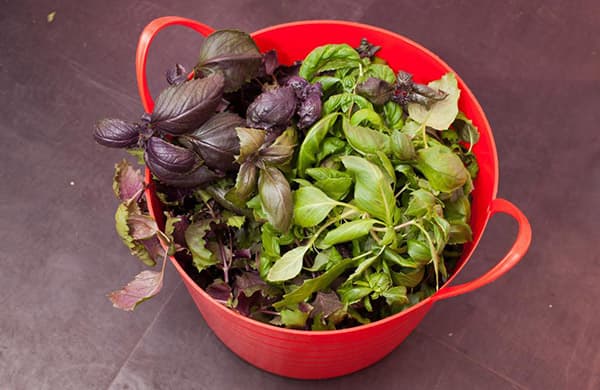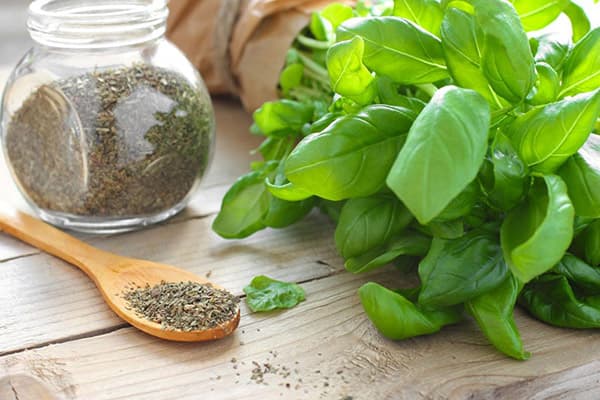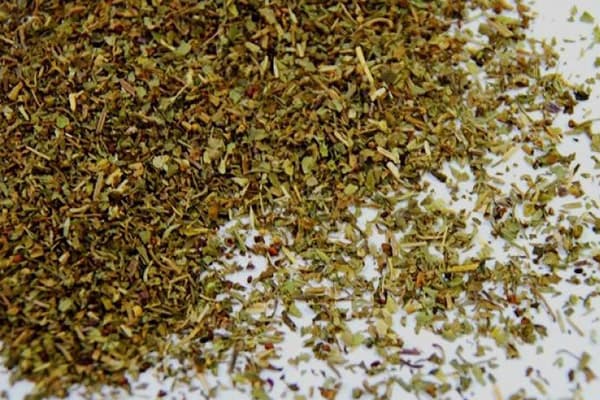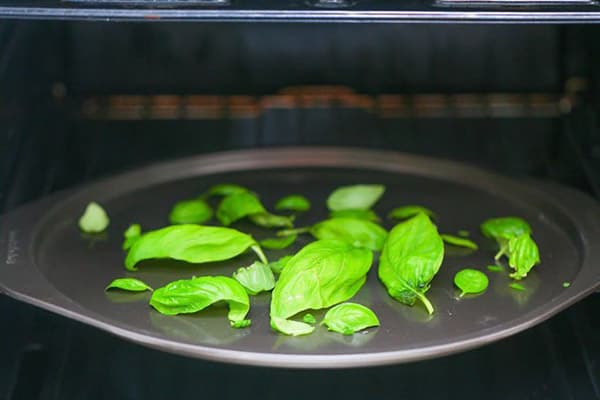Drying basil: 4 ways to prepare aromatic spices
Drying basil at home is quite easy. And even economical, if you consider the difference in price between greens grown independently or purchased in the summer and ready-made dried products from the store. And this is an excellent reason to start harvesting this fragrant herb right now.

Preparing the Basil
Before you start drying, the basil needs to be properly prepared. This procedure consists of only three steps:
- The washing up. Greens purchased on the market need “water treatments” just as much as those collected from your own garden. Under the tap, particles of dirt stuck to leaves and stems, small insects, as well as the main part of pathogenic microflora are removed.
- Pre-drying. If you get rid of the droplets that remain on the surface of the grass, the further process will go faster. The easiest way to do this is to blot the basil with a linen or paper towel and lay it out for a while on a surface that can absorb water (for example, dry napkins or cloth).
- Separating leaves and stems. There is no need to throw away the stems, as they are also used in cooking. However, given the fact that they are much harder and thicker than leaves, in most cases they have to be dried separately.
By the way, you need to dry the basil leaves correctly - entirely. If you cut them, almost all the essential oils will evaporate and the greens will lose the aroma for which they are valued and for which they are prepared for the winter.
Drying methods
There are several ways to dry basil at home. All of them differ in the duration and quality of the finished product.
On open air
This is the easiest way to dry basil at home. It does not require any equipment, but this is its only advantage. There are more than enough disadvantages:
- Depending on the temperature and humidity, drying can take from several days to a week.
- Dust and dirt settle on the leaves because they are not protected by anything. Then all these “additives” will end up in the food, since it is not customary to wash dried herbs before adding them to the pan.
- During exposure to the open air, most of the essential oils evaporate from the grass, which negatively affects the aroma of the finished product.
- If the greens are exposed to direct sunlight, they will lose their beautiful color.
You can dry basil in this way either in bulk or hanging. In the first case, it is recommended to separate the leaves from the stems; in the second, it is better to leave everything as is, since it is more convenient to collect the greens in bunches and attach a rope to them.
Each option has its own characteristics:
- When drying in bulk, the leaves are placed on a light, clean cotton cloth or white paper. You should not use newspapers and other printed materials - the grass can absorb the smell of printing ink. The greens are turned several times a day.
- If it was decided to dry the basil in bunches, they should be placed at a sufficient distance from each other and from other objects. It is advisable to tie no more than 7 stems together - this way the grass will dry faster and better.
During drying, the grass is shaded.It’s good if the place where the basil is located is blown by the wind - this speeds up the process. Indoors, air movement can be created artificially by installing a fan.
In the oven
A common method of preparing basil for the winter is oven drying. However, it should be remembered that for such a thing you will need a temperature of 35 to 45 ° C, and for most ovens the minimum possible heating is 100 ° C. For this reason, many housewives encounter failures, ending up with over-dried, sometimes burnt greens without a distinct odor.
Leaves and petioles should be dried separately, at least on different baking sheets. It is advisable to line the metal surface with paper (both regular stationery and baking parchment will do).
The entire time the herb is in the oven, the door should be open - this will allow moisture to escape. Turn the basil periodically to avoid uneven evaporation of the juice. Drying lasts from 2 to 6 hours, depending on the number of leaves and other conditions.
In the microwave
This method has three advantages:
- Speed - with a power of 750 W, the entire process takes no more than 5 minutes.
- Preservation of aroma - when using a microwave, over 80% of essential oils are retained in the leaves, so the smell of greenery does not change or weaken.
- Color preservation - due to the rapid evaporation of moisture, chlorophyll (the substance responsible for the green color) and anthocyanins (purple coloring substances) do not have time to break down. This makes dried basil look exactly the same as fresh.
Before placing the basil in the microwave, be sure to dry it, leaving it on the table overnight.Then they place it on a light, fireproof plate without any patterns, in the center of which they place a glass half or two-thirds filled with water - it will absorb excess electromagnetic energy.
Drying should be carried out in several stages, each time setting the microwave oven operating time for 1 minute and stirring the leaves after the sound signal. This way the greens will lose moisture evenly. As a rule, three turns on the microwave is enough.
What you should absolutely not do:
- spread the leaves in a thin layer - they will dry out and stick tightly to the plate;
- cover the basil with a lid - condensation accumulates on it and flows down, which is why the greens get wet, and it is not possible to obtain the desired result;
- leaving petioles on the leaves - as practice shows, they ignite, which is extremely unsafe.
Remember - when drying basil in the microwave, you need to control the process from start to finish. Leaving the device turned on without supervision is highly recommended. Before starting work, you should read the instructions for your microwave oven.
In an electric dryer
If you have a special dryer, you can harvest greens in large quantities. To dry basil, set the temperature to 35–45°C. The advantage of this device over the oven is that the leaves do not need to be turned over: thanks to the presence of holes in the grates, the grass dries evenly. However, you should not abuse this and spread the greens in too thick a layer.
The rest of the process is the same as in the oven. The smell of basil from an electric dryer and from the oven is no different. The time costs are also identical.
Completely dried greens, which crumble easily between your fingers, should be immediately collected and placed in linen or paper bags. Glassware is also suitable for storage. But cellophane bags and plastic containers are the worst option of all. If you have dried the basil using heat (such as in the oven), you should wait until the leaves have cooled before placing them in an airtight container, otherwise they will become moldy.




Place several paper napkins on a plate, lay out twigs, or better yet, leaves of basil, or dill, or parsley, and cover the top with a boom. with a napkin and in the microwave and quickly and the smell of greenery can be felt
I dried basil in the microwave for the winter. I liked this method the most. Fast and simple.